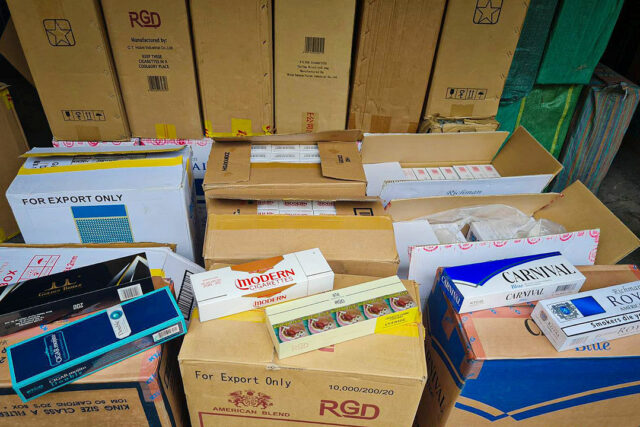Philippines, US start annual war games in locations facing regional flashpoints

By Kenneth Christiane L. Basilio, Reporter
ABOUT 14,000 Filipino and American soldiers kicked off their annual combat drills in the Philippines on Monday, with the war games to be staged near key locations facing regional flashpoints like the South China Sea and Taiwan.
The Balikatan (shoulder-to-shoulder) exercises will run for three weeks until May 9, and will showcase an array of US weapons that include the Navy-Marine Expeditionary Ship Interdiction System (NMESIS) anti-ship missile system and High Mobility Artillery Rocket System (HIMARS).
Military forces from Australia, Canada, France, Japan, South Korea and the United Kingdom will also participate in the drills, while 16 other nations including Malaysia and Singapore will act as observers, according to a statement from the Philippine military.
“We will train shoulder-to-shoulder so that we are prepared to operate shoulder-to-shoulder and, if called upon, to fight shoulder-to-shoulder,” US Lieutenant General James F. Glynn, exercise director for the US side, said in a speech during opening ceremonies at Camp Aguinaldo, the Philippine military’s headquarters near the Philippine capital.
Started in 1991, the Balikatan exercise has evolved into Southeast Asia’s premier combat rehearsal as the Philippines and US seek to strengthen security cooperation and enhance force interoperability in response to China’s growing assertiveness in the region.
The South China Sea has become a flashpoint for Southeast Asia as China continues to assert sovereignty over almost the entire sea, seen as a vital global trade route that is also believed to be rich in undersea gas and oil deposits.
Philippine and Chinese forces have repeatedly clashed over competing claims in the sea, with tensions flaring around disputed maritime features such as the Spratly Islands and Scarborough Shoal.
“More than 14,000 participants and over 20 nations are invested in what is now a signature exercise dedicated to maintaining a free and open Indo-Pacific region and ensuring the defense of the Philippines,” Mr. Glynn said. “Nothing builds bonds more quickly than a shared adversity.”
Beijing also claims self-ruled Taiwan as its own territory and has routinely staged air and naval military drills that has put Taipei on a war footing. China has not ruled out the use of military force in annexing the island, putting its 23 million citizens and the world’s most advanced semiconductor factories at risk.
About 9,000 US soldiers and 5,000 Filipino troops will participate in the drills.
An invasion of Taiwan is not “conducive to a free and open” South China Sea, Mr. Glynn told reporters after the opening ceremony. The Philippine-US drills are structured to address broader “regional security challenges” in the South China Sea rather than to counter a potential Taiwan conflict.
“Whenever we conduct exercises, we focus on defense, not attacks,” Philippine Major General Francisco F. Lorenzo, exercise director on the Philippine side, told the same news briefing.
Mr. Glynn said the US military would deploy its advanced missile systems for the drills, including a mobile anti-ship missile system, a portable artillery rocket system, a mid-range capability missile battery and a short-range air defense platform.
“[We will] introduce new capabilities, like the Navy-Marine Expeditionary Ship Interdiction System, Marine Air Defense Integrated System (MADIS) and the army’s medium range capability for the Typhon missiles,” he added.
US Defense Secretary Peter Brian Hegseth in late March vowed to help arm the Philippines with deterrence capabilities by deploying advanced weaponry, such as the NMESIS and unmanned sea vessels.
Outside the military headquarters, activists led by Bayan Muna burned a US flag to protest the war games. “Stop militarization,” according to one banner held by a protester, while another urged the US not to drag Filipinos in the war with China.
‘CREDIBLE COMBAT POWER’
Meanwhile, the intermediate-range missile system can launch missiles that could reach the Chinese mainland. It was flown to the Philippines for last year’s Balikatan drills and has since drawn sharp criticism from Beijing.
“[These] are all here to bring together our capabilities, to demonstrate and reassure to the region that while we remain committed to peace, we also possess credible combat power… to maintain a free and open Indo-Pacific,” Mr. Glynn said.
The military drills reaffirm the Philippine and US commitment to keeping regional peace and bolstering military preparedness for “future challenges,” Armed Forces of the Philippines Chief-of-Staff Romeo S. Brawner, Jr. said in a speech.
“Our operations span complex joint endeavors including missile defense, counter-landing live fires and man-tank strike capabilities, alongside humanitarian efforts and infrastructure projects that directly benefit our local communities,” he said. “These initiatives are not solely about demonstrating power. They epitomize partnership in action.”
This year’s drills will be mostly concentrated in northern Philippines and its west coast.
Two military exercises — one on the major Philippine island of Palawan near the South China Sea and another in Cagayan province facing Taiwan — will see forces rehearse how to repel an invasion and test the Philippine military’s coastal defense system, according to a handout.
Joint Philippine-US forces will also carry out exercises to assert control over “vital maritime regions” by securing key infrastructure including ports, straits and strategic islands in western and northern Philippines, aimed at refining military tactics for safeguarding crucial maritime assets in case of conflict.
They will also hold naval drills with Japan in the West Philippine Sea, where Philippine and Chinese forces have repeatedly clashed. A decommissioned Philippine Navy ship will be sunk in a separate exercise within the same waters.
Meanwhile, China’s Southern Theatre Navy said a Philippines frigate had “illegally intruded” into the waters of Scarborough Shoal on Sunday, “seriously violating” Chinese sovereignty and laws.
The navy monitored and drove the vessel away, it said in a statement late Sunday. It urged the Philippine side to immediately stop the “infringement and provocation,” its spokesperson said.
The Philippine Embassy in China did not immediately respond to a request for comment. — with Reuters












